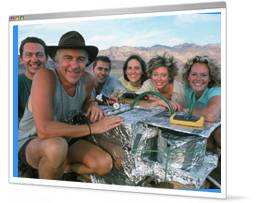My UPD8
You need to login before you download the free activities. You can register here.
- The Centre for Science Education
- The Association for Science Education
- Partners
- Part of ASE online
Rough Science 4: Crater impact

Type: Activity
Learning Strategy: Problem solving
Topic: Forces
Crater Impact is a fun, easy to use investigation into kinetic and potential energy. It is set in the context 'If a large asteroid hit the Earth, could it cause global catastrophe?' Pupils simulate asteroid impacts on a tabletop scale by dropping objects into sand. They can investigate how the speed and mass of their 'asteroid' affects the distance that the debris travels or the size of the 'crater' produced.
The activity addresses the whole range of investigative skills. It is a specially adapted version of a popular brief from the Pupil Researcher Initiative.
Published: 23rd January 2005
Reviews & Comments: 2
Try the activity
Please login to download activities
Curriculum link
KS3 QCA Unit 9J Gravity and Space / 9K Speeding Up / 9M Investigating Scientific QuestionsKS4 Single/Double Science: Forces and their effects
Running the activity
Pupils read page 1 Crater Impact : Science fact or fiction to set the context.
Page 2 is a help sheet.
Asteroid speed Pupils are told that dropping the object from different heights gives it a different speed on impact. Speed is used (rather than height) to make it easier to predict the effect on the kinetic energy of the asteroid and thus the effect of the impact.
Asteroid mass This can be varied using objects of different sizes. For a fair test, these should be made of the same material e.g. all ball bearings or plasticine. Mass is used (rather than diameter) to make it easier to predict the effect on the kinetic energy of the asteroid and thus the effect of the impact.
Debris range This is the furthest distance any sand from the 'planet surface' travels.
Sprinkling powder paint over the surface with a sieve and tapping the container so it settles makes measurement easier.
Crater size This is the diameter of the crater that the dropped object makes.
Pupils than plan their investigation, using the question prompts on the help sheet - page 2.
Knowledge of the formula for kinetic energy is needed to make predictions about how the speed or mass of the asteroid will affect the impact. Pupils are told that the bigger the kinetic energy, the bigger the crater and the bigger the debris range. It is worth doing a trial run to check that there is enough sand/powder in the tray.
Extension activities- pages 3 and 4
These activities exploit the context of the investigation, giving it a more personal dimension. Pupils can scale up their results to estimate the effects of a real impact, and also consider ways we could protect ourselves from a collision. They get more practice of calculations and thinking about probabilities.
Some of the activities are more appropriate for brighter pupils.
Web links
News links
- Rough Science
- Try the activities
- Pupil Researcher Initiative
- For more investigations set in contexts such as this, see the Pupil Research Brief from PRI. These were sent to all schools in 1995/96, and are now available on the PRI website
Reviews & Comments
Write your online review to share your feedback and classroom tips with other teachers. How well does it work, how engaging is it, how did you use it, and how could it be improved?
Cojoined twins
Dec 8th, 2007

Up popped Cojoined Twins, just as I was teaching about asexual and sxual reproduction. The story captivated my Yr 10 and inspired them to discuss some deep opinions.
Reviewer: Wendy Greenleaf
Earth & Space: Crater Impact
Oct 9th, 2006

I tried this exercise on my Y10, single subject Physics group for the "Earth in the Universe" P1 module. They found it quite challenging, but it was extremely useful to me for differentiation of ability within the group.
Reviewer: Stephen Clark

200 lessons and assessments from as little as £4.95
Related Activities
Ideas about Science / Doing enquiry
- Javelin jeopardy
- Leaning tower
- Crater Impact
- Snow Blanket
- Fingerphone
- Faster Freezing
- World Cup Science Challenge
- Wired or tired?
- In the limelight
- Text neck
QCA / 9K Speeding up
- Backstage science
- Fast car
- SpaceShipOne
- When will women overtake men?
- Tsunami Warning
- High Speed Risk
QCA / 9J Gravity & space
Physics / Forces
- Sports clinic
- Leaning tower
- Robot explorer
- Sputnik at 50
- Ellen's moments
- High Speed Smash
- SpaceShipOne
- Shampoo claims - truth or lies?
- Think 30 for a reason
- Rugby forces
- Text neck
Learning Strategy / Problem solving
- Rough Science 1: Find water
- Rough Science 2: Communication
- Rough Science 3: Spacesuit challenge
- Rough Science 5: Survival
- Rough Science 6: Rocket lander challenge
- Gold
- The atomic clock at 50
- Snow Blanket
- Solar Car Challenge
- Pirates treasure mystery
- Cracking da Vinci's other code
- Time raiders - death of a mummy
- Vanished - a blitz mystery
- Levitating train mystery